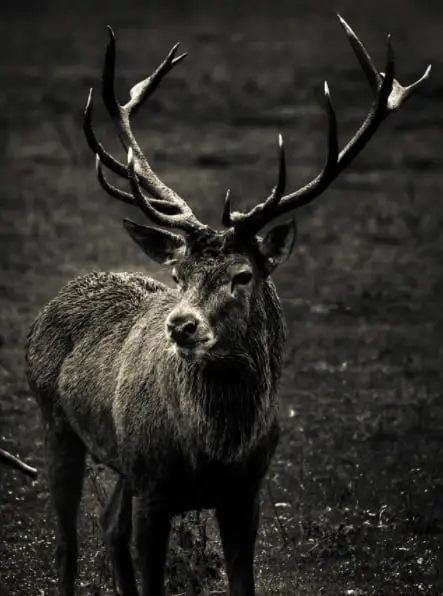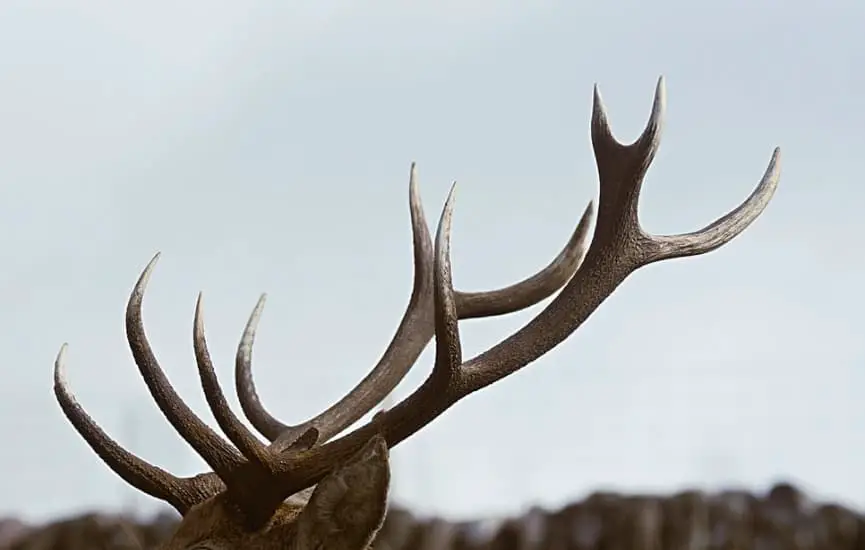As an Amazon Associate I earn from qualifying purchases.
Our Associate portal can be found here
It’s almost that time of year again when we’re all out in the field and woods looking for those elusive 12-point bucks. You’ve often heard folks boasting about the points on the bucks they’ve harvested, so what are 12-point bucks?
In adult male deer, a 12-point buck refers to mature male deer approximated to be at least 5 to 7years old. Points on a given buck refer to the distinct tines of the antlers. The specific number of tines on the antlers is the determiner of the points in a buck. For instance, an 8-point buck has eight unique tines, whereas a 12-point buck has 12 individual tines. Antlers in male deer are very distinct in terms of their physical structures.

You can differentiate female deer from bucks easily since the does don’t have defined antlers, except for the female caribou deer that have antlers. Read on as I elaborate conclusively on what points are and how they are used to gauge a buck’s age and suitability for harvest.
How Can Deer Antlers Be Best Described?
Antlers are an extension of the deer’s skull. They are single structures mainly found on male deer, made up of blood vessels, nerves, fibrous tissue, cartilage, skin, and bone. As the buck continues to age, more points tend to develop on his antlers.
In general, the more points on a buck, the more prestigious it is for you if you can manage to harvest him. You can also mount these antlers as trophies, especially the large racks.
A 12-point buck refers to the number of protrusions or antler lines on a mature male deer. The 12-point buck will have six tines in a balanced pattern on both antlers. These antlers start growing in April since there is an increase in sunlight levels, becoming hardened by the end of summer.

A twelve-point buck sheds off his antlers after every mating season. That’s because the male deer rubs against trees and mounds, causing the velvet that covers his antlers to come off. Prime antler sizes in bucks can be attained when the deer reaches between four and seven.
What’s the Significance of Points in Bucks?
Points are an important consideration when deciding whether you will keep the buck’s antler as a trophy or not.
In some instances, various wildlife management agencies have set up point limits. To harvest such a buck, it must have attained a specific number of points. However, the said point limits refer to points on a single antler to keep the buck populations strong.
In addition, some researchers are fascinated by the formation of antlers and their impact on different environmental changes on buck antlers. A 20-point buck, therefore, refers to the size of a buck’s antlers. That means that the rack will have twenty points inclusive of all the tines and the central beam.
However, there are two separate ways of counting points on a buck’s antlers. There is the Eastern Count and the Western Count.
What is the Age of a 12-point Buck?
Except in some unique places, you will find many bucks over five years of age. In most instances, the 12-point bucks are mainly those bucks that are between 5-7years of age.
At this point, these bucks have already achieved 90 to100 percent of the maximum antler growth.
How Do You Count Antler Points in a Buck?
Counting antler points in a buck involves measuring every protrusion from the point protrusion leaves the chief beam to the tip. If a point measures one inch or more in length from the central shaft, it’s then counted as a point.
This means that if there are twelve points in a buck, it automatically becomes a 12-point buck.
Factors That Determine the Overall Points on a Buck’s Antlers
The number of points on a buck’s antlers is mainly determined by:
Availability of Proper Nutrition
A healthy diet provides the bucks with vital nutrients needed to grow longer and more captivating tines. Large herd sizes where there is resource competition are not the best for optimum antler development.
His Age
A young buck will not attain the antler length for 20 points until he’s at least four years old. You should avoid harvesting very young bucks as a way to manage the growth of optimum antlers. The best time to remove a 20 point buck is between the ages of five and eight.
Genetics
Antler growth can be determined by the type of deer and the specific family history of that buck. With selective hunting, you can optimize the chances of harvesting a 20-point buck from your target deer herd.
Other ways a hunter can determine the number of points include measuring the length of points, beam length, and spread.
How to Tell the Different Points in an Antler
Bucks antlers have various main parts, including the top beam as the focal branch of the antler. The tip of this chief beam counts as one of the antler’s points. Close to where the antler emerges from the head is a brow tine, a tiny tine protruding straight up.
When the brow tine is present, it’s counted as a point. Some of the pointed branches produced by the antler are known as top tines. The combined points on a given buck signify the total of the individual tines on the two antlers.
How to Differentiate 12-Point Bucks From Others
The main differentiating factors for bucks and their points are their age and general physical appearance. Keep in mind that 12-point bucks are of ages between 5 and 7 years.
The following are some of the differences between 12-point bucks and younger or older bucks;
One-Year-Old Bucks
These are the easiest to identify since they have thinner necks compared to the older bucks. One-year bucks have long legs compared to their bodies, which gives them a lean appearance.
The one-year bucks have a unique line that separates the shoulders and necks, bringing out some muscle definition. In addition, they have narrow waists, and they may also have slight staining in the tarsal glands.
Antlers on these bucks can be inconsistent, but they have relatively short and thin beams. If one-year bucks live in properly managed environments, they may even have ten or more points.
Two-Year-Old Bucks
The legs on these bucks appear long, so much that they may seem awkward and gangly. They have thin waists, and the shoulder muscles aren’t completely defined yet.
Two-year bucks display some build-up of the neck muscle during the rut and moderately stained, round, and small tarsal glands. Their antlers have a spread that is almost the same width as their ears, and the beams clearly show the start of some multiple points.
Three-Year-Old Bucks
These bucks have thickly muscled shoulders and necks, but their necks can still get differentiated from their shoulders. Their stomach and back lines are comparatively taut and straight.
At this age, a buck’s chest starts to become deeper compared to his hindquarters. A three-year-old buck still has a thin waist, giving him somewhat of a racehorse or linebacker appearance. The legs tend to suit the length of their bodies.

Three-year-olds buck’s antlers can spread outside or within the ears when there’s a decent mass. His tarsal glands have a dark appearance during a rut, and he will display plenty of attaining. Research has shown that these bucks have achieved 50 to 75 percent of maximum antler growth capacity at this age.
Four-Year-Old Bucks
A four-year-old buck has a fully muscled neck. The neck blends into his properly defined shoulders, while his waist appears dropped down. His limbs keep straight with the gut. But this buck looks like the legs are short for the body.
An essential point to note is that a four-year-old buck has a body form that’s not sagging yet. That’s in comparison to 12-point bucks that are a little older. The hind-end in these bucks appears rounded and filled out.
Additionally, a four-year-olds face has taunt skin surrounding his jaw. The antlers are now starting to display their full potential, and they should be a bit heavy with multiple points and suitable bases. These bucks also have larger, dark-stained tarsal glands during the rut that possibly extend down to their legs.
With proper nutrition, four-year-old bucks are structurally mature, and they can attain 75 to 90 percent of their maximum antler growth capacity. These bucks have different appearances as compared to one and 3-year old bucks.
Five to Seven-Year-Old Bucks
Five to seven-year-old bucks have some characteristics of 4-year-old bucks. That includes heavily swollen necks during the rut, waists even with their chests, and heavily muscled shoulders. Additionally, they may have sagging backs and pot bellies.
Such 20-point bucks also have increased body masses, making them rounded appearances. They resemble small cows, and at this age, have attained at least 90 to 100 percent of their antler’s growth maximum potential.
In addition, they have tarsal glands that are highly stained during the rut, with this stain going below the tarsal glands. These are the unique physical characteristics that differentiate the 12-point bucks from their counterparts.
Eight-Year-Old Bucks and Older
A few bucks that range freely make it to eight years of age, also termed being post-mature. Bucks beyond eight years have already passed their prime and tend to regress in antler and body size. They also have loose skin on the shoulders, necks, and faces, and they may also have pointed hip bones and shoulders.
Antlers on eight-year-old bucks may display abnormalities that are age-related, including curvy or wavy tines. In addition, they have a weathered appearance.
When studying the specific body characteristics related to age, you will notice that there aren’t any specific age-related antler characteristics. Besides, there are ranges of the maximum potential of antler points attainable in the different ages. You can’t estimate these percentages adequately by simply looking at the antlers.

It’s essential to not rely solely on the antler size when trying to get the points or age of the bucks. There are instances where you will find large antlers in younger bucks and smaller antlers in older males. That can negatively influence your conclusion when estimating their age or points.
The best way to decide whether or not it’s a 12-point buck is by looking solely at the points on the two antlers. Whereas age is a good indicator of the points in different bucks, checking the physical characteristics is crucial when coming to this important conclusion.
Summary
Being sure of the age of the points in bucks gives them a better chance of survival and maximizes their population. For instance, telling if a buck is a 12-point or not enables you to decide whether or not to hunt him, especially if the buck is relatively younger.
The 12-point bucks come with unique features that make it easier to differentiate them from others. What’s better than going for a hunt and hunting down that 12-point buck whose antler you can use as a treasured trophy?
Amazon and the Amazon logo are trademarks of Amazon.com, Inc, or its affiliates.

36 years old, been hunting and fishing my entire life – love the outdoors, family, and all kinds of hunting and fishing! I have spent thousands of hours hunting hogs and training hunting dogs, but I’m always learning new stuff and really happy to be sharing them with you! hit me up with an email in the contact form if you have any questions.



